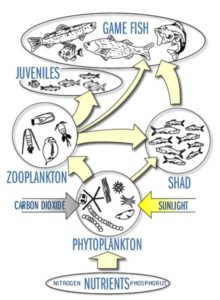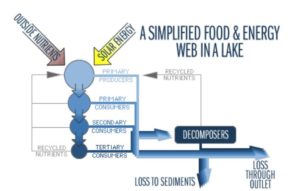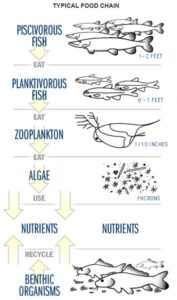Food chain
A simple introduction to the idea of a lake’s food web is to think of it simply as bigger fish eat smaller fish that eat the small floating critters that eat algae, as in the first diagram. Algae are the primary producers, that is, they are able to convert light, nutrients, minerals, and carbon dioxide into organic materials and provide the food that is the basis for life in the lakes. In this model, primary consumers are zooplankton which feed on algae, secondary consumers eat zooplankton, tertiary consumers eat the fish, and still larger consumers like osprey or bears are the next level consumers. As each level of consumer lives and expends energy, less energy or food is left for the next level up, so a lot of algae are required to support a few large fish.
Food web
Reality is more com plex. Piscivores are a category of fish that prey on other fish, but when they are young and small, they may eat algae, detritus, or zooplankton directly before they grow large enough to become a top predator and eat other fish. Some fish may prefer one food but eat other food that’s more available. The food relationship can be envisioned more like a food web, and can consist of hundreds of species.
plex. Piscivores are a category of fish that prey on other fish, but when they are young and small, they may eat algae, detritus, or zooplankton directly before they grow large enough to become a top predator and eat other fish. Some fish may prefer one food but eat other food that’s more available. The food relationship can be envisioned more like a food web, and can consist of hundreds of species.
Microbial loop
That more complex diagram still doesn’t tell the whole story. A significant component of a lake’s food web consists of the microbial loop. The decomposition of organic matter recycles nutrients back into the water column through the action of bacteria and benthic detritivores. These bottom feeding creatures eat or decompose the debris that sinks as algae, plants, and animals die, and with the help of bacteria, make the nutrients available to the plants and algae. 
What about plants?
You may notice that aquatic plants aren’t prominent in any of these diagrams. While underwater “weeds” are an important habitat for fish and other lake creatures, the living plants are not usually a significant food item for fish. Aquatic plants support a layer of biofilm that attaches to almost all submerged surfaces. Periphyton, or attached algae, can grow as part of or on the biofilm. Some insects may live on the plants or biofilm. When plants die, their detritus becomes a source of nutrients for bacteria and macroinvertebrates.
This food web and transfer of energy is one element that makes our lakes so important as habitat. It’s also a reason that our lakes will never be as pristine as a swimming pool. Of course, having too many nutrients can be bad for both the lakes and for our enjoyment.
